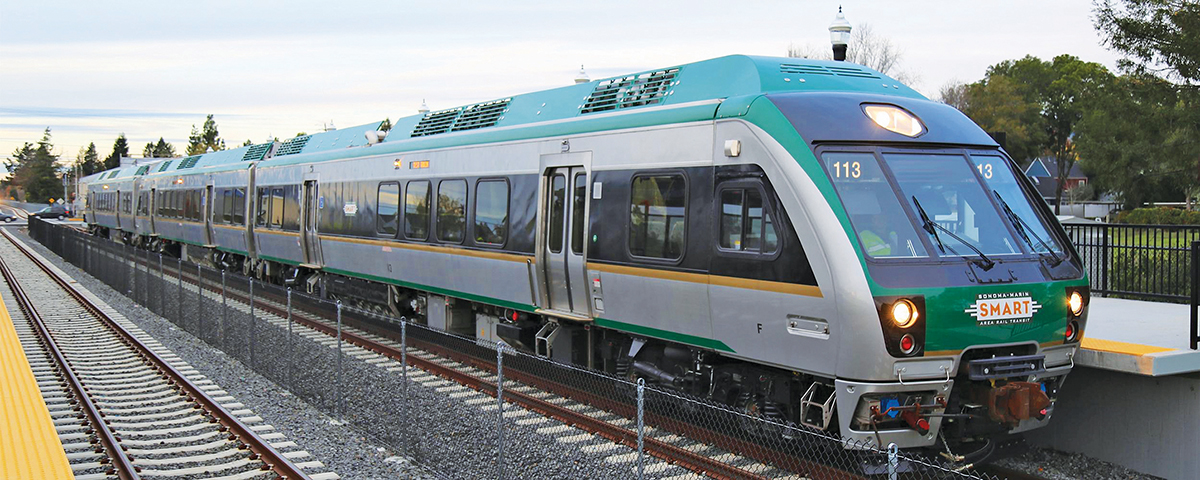
Inauguration of Sonoma-Marin Area Rail Transit service from Santa Rosa to San Rafael in 2017 was one highlight of regional rail implementation from MTC’s 2007 plan. Photo courtesy SMART.
In 2007, the Metropolitan Transportation Commission (MTC) adopted a regional rail plan that envisioned opportunities to accelerate Bay Area travel with an integrated network.
The vision described how to “ring the Bay with rail” by better connecting San Francisco, Oakland, and San Jose. It charted a course through 2050 in which BART and Caltrain served as the rail network backbone, and called for a new governance structure to deliver high-quality, efficient services, among several other recommendations.
Transportation agencies delivered on a number of the plan’s projects, including the SMART (Sonoma-Marin Area Rail Transit) train launch in 2017 and the opening last year of the Salesforce Transit Center, which will eventually bring in Caltrain service from the South Bay and California High-Speed Rail from Southern California into an underground station. A few other key projects remain under development. But governance is proving tricky.
The region “has fallen short on many of the [2007] policy recommendations, particularly the bold policy changes to reform governance and project delivery,” according to documents from an October 11 presentation made during a joint committee meeting of MTC and the Association of Bay Area Governments (ABAG).
The challenge before transportation planning officials is a “crowded field” with “a lot going on,” according to meeting documents. The field in question is comprised of 10 services that run lines in the nine-county Bay Area and surrounding “mega-region” that includes Sacramento, Monterey Bay, and the San Joaquin Valley. At least two more services, Valley Link and California High-Speed Rail, are under planning.
Within this field, Bay Area commuters often find that local rail service is not reliable or frequent enough to reduce the need to drive, advocates told the Monitor. For example, BART ridership hit a peak in 2016, but crime, cleanliness, and other service concerns have since derailed the record-setting streak. Overcrowding in the Transbay corridor also is limiting BART’s capacity.
When taken together, do all of these complexities necessitate a new look into how the region funds and builds its rail system?
MTC is taking stock of projects and development. The idea behind the October 11 presentation was “to gauge the Commission’s interest in how they’d like to move forward with rail planning in the near term,” said Adam Noelting, principal planner and analyst at MTC, during an interview with the Monitor.
Meeting documents briefly laid out three core areas in which MTC could evolve its role to support passenger rail. The first is prioritizing cost-effective and equitable investments. The second is promoting land-use strategies that support rail projects. This step will likely include a 2020 revamp of transit-oriented development policy that considers factors such as recent housing legislation and insights into the Regional Housing Needs Allocation process.
Lastly, it’s important for MTC to develop partnerships and organizational opportunities to coordinate and deliver the next generation of rail investments.
Related to this evolution is Plan Bay Area 2050, a growth roadmap for transportation, housing, the economy, and the environment that MTC is in the midst of creating. It’s relying on a project performance assessment to tease out the benefits of nearly 100 project proposals that are evaluated based on cost-effectiveness, equity impacts, and alignment with guiding principles. A good chunk of these comprise rail investments, focused on building core rail, extending the network, and optimizing the existing network. Plan Bay Area 2050 will be complete in 2021.
Additionally, MTC is studying seven Transbay Crossings concepts, each profiled in a perspective paper published in early November and developed as part of the agency’s Horizon initiative. Horizon considers “what if” scenarios and how they’d perform against three different population growth projections. The perspective paper recommended prioritizing three “transit-only” ideas for further analysis and possible inclusion in Plan Bay Area 2050. Two focus on a new BART crossing that connects Oakland and other East Bay cities with San Francisco, with some variations. The third is a “Greater Regional Rail” concept that would link Oakland and other East Bay cities with San Francisco and the South Bay by integrating Caltrain and Capital Corridor service through the Salesforce Transit Center.
Transportation advocates are on board with the need to re-think how transportation officials, agencies, and providers work together to tackle core functions and reduce redundancies. They believe Bay Area commuter rail, and public transit overall, could become more robust when all the broad brushstrokes — delivery, operations, and supportive land-use — are in line.
“We think of our regional transit system segmented by whether the transit vehicle has steel wheels or rubber tires, rather than thinking about it collectively,” said Adina Levin, cofounder of two transit advocacy groups — Friends of Caltrain and Seamless Bay Area — during an interview with the Monitor.
Rider experiences could really change as a result. A unified, well-coordinated schedule allows people to transfer more easily, said Laura Tolkoff, regional planning policy director at the nonprofit SPUR. For example, when you have a rail station with service every 15 minutes that’s available all day long, that’s a “good candidate for growth.”
However, Bay Area transportation projects are funded via local and county sales taxes, which makes it hard to prioritize projects that have a regional benefit, Tolkoff said. There also are inconsistencies in land-use decisions, which are made by local municipalities that may lack necessary tools to focus development around transit stations.
Indeed, regional rail is “not a conversation that fits neatly within the nine-county region,” said Sebastian Petty, director of policy development at Caltrain. “It’s also a megaregion and statewide conversation.”
Caltrain’s board recently adopted a 2040 Service Vision that calls for increased service, frequency, and longer trains to triple ridership. The vision also prepares Caltrain to expand and integrate into a regional rail network that includes the potential for renewed service across the Dumbarton Bridge and the rebuilding of Diridon Station in San Jose.
California’s 2018 Rail Plan left service vision breadcrumbs for agencies like Caltrain and others to follow, with goals to increase passenger rail travel by 92 million passenger-miles per day. It outlined an integrated system that will allow passengers to easily and efficiently transfer from local transit services to regional, intercity, and future high-speed rail. This all makes for a greener, safer, more efficient, economy-boosting way to travel.
Potential next steps for Bay Area rail planning may be shared after a January MTC workshop, which will focus on partnership and organizational challenges related to coordinated project delivery. That could include service planning in corridors where there are many projects, sponsors, and cities involved. Discussions from the workshop could eventually lead to a new rail plan, direction, or topic area, Noelting said.
Cecily O’Connor covers transportation for the Monitor.

